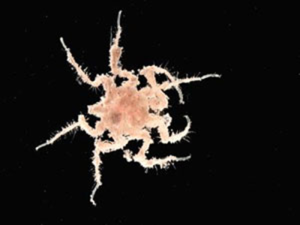Sea Spiders
Sea Spiders, Class Pycnogonida
| Sea Spider | |
|---|---|

| |
| Pycnogonids are often called sea spiders because their body form resembles that of terrestrial spiders. | |
| Scientific classification | |
| Kingdom: | Animalia
|
| Phylum: | Arthropoda
|
| Subphylum: | Chelicerata
|
| Class: | Pycnogonida
|
← Arctic_Life | ← More Animals | ← More Invertebrates | ← More Marine Invertebrates
Pycnogonids (pyc="thick"; gonida="knees") are usually called sea spiders because of their superficial resemblance to true, terrestrial spiders. Pycnogonids have a wide geographical distribution, occupying every ocean on the planet at various depths – from very shallow areas to nearly 7 km! In Canada, 19 species inhabit the High Arctic, of which 13 belong to the genus Nymphon.
General Information and Anatomy
Although the body of a pycnogonid is not divided into distinct segments like other arthropods, there are three recognizable regions: the head region, trunk, and abdomen. The head region bears many specialized structures, including a tube-like proboscis, paired appendages, and a dome-like projection with four simple eyes. The proboscis is a food-gathering organ in which the mouth is situated. Paired appendages occur in the form of cheliofores, palps, and the first pair of walking legs. Chelifores are used to grasp prey items and to thrust them into the mouth. Palps are thought to have a sensory function in addition to aiding the chelifores in handling food.
Behaviour and Distribution
Most pycnogonid species wander around the bottom of the ocean for their entire lives, but some live on other invertebrates, such as sea anemones and tunicates. The diet of pycnogonids is not well known. A few species feed on algae, but most prey upon soft corals, sponges, and ectoprocts. Three teeth at the tip of their proboscis pierce prey and suck out body fluids and tissue fragments.
Sea spiders are either male or female. During mating, the male hangs beneath the female and fertilizes her eggs as she releases them. The male then carries the embryos on his first pair of walking legs for a period of time before they are released as young pycnogonids. Pycnogonids exhibit a tendency to be larger in arctic waters. This gigantism is often attributed to low temperatures and low metabolism. Most sea spiders have a body size of less than 1 cm, but some polar pycnogonids have leg spans of 70 cm!
External resources
| Name | ID |
|---|---|
| NCBI Taxonomy | 57294 |
| WikiSpecies | Pycnogonida |
| Wikipedia | Sea Spider |
| iNaturalist | Pycnogonids |
| BOLD | 26059 |